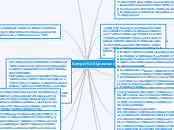Sample Questions
Maximal lactate producing capacity is increased in a highly trained individual compared to an untrained
individual because of: more glycogen
. If Samantha and Kelly lift the same amount of weight for a dead lift exercise, but it took Samantha 2 seconds
longer to complete the lift, then Samantha:
All of the following points are important to consider when working with a visually impaired person E
Keep areas
B Give verbal
C Keep light levels low
8. Athletes are told to practice the 3 R’s when recovering from exercise in training or competition. What do the
3 R’s refer to?
A Rehydrate, Refuel, Repair
Jenny is a 73 year old woman who has been active her whole life. She has been cycling 30-40 kilometers 3-4
times per week and walks with a pole walking group two days per week. In the winter she skies (downhill) and
takes indoor cycling classes. This summer she has noticed that she can’t keep up with her peers on rides. She
can go the distance but her speed has significantly decreased.
1. Which of the following conditions may be responsible for this change?
Sarcopenia
3. In terms of prescription, Jenny agrees to go to the gym for 15 mins, 3 times per week. Which exercise is
essential to include for her to improve?
A Resistance training for the lower body
5. Jenny comes back a year later and says that her doctor told her she has osteopenia. She is continuing with
her cycling but you tell her she:
A Needs to start doing more resistance training to ensure she maintains her bone mass
B Needs to cut down on cycling and do more walking to ensure she increases her bone mass
Sujet principal
5. Which of the following is an acceptable spirometry maneuver?
A The two largest measures are within 0.15 L of one another.
6. Asthma is the most common chronic condition of childhood. As a CSEP-CEP working with young hockey
players, you are informed that one of your players has exercise-induced bronchospasm (EIB). You suggest?
A Recommend beta-2 agonists as a rescue medication 15-30 minutes before the youth exercises.
B Suggest non-pharmacological interventions such as a longer duration warm-up or use of a mask to warm air
on inhalation and monitor response.
9. An individual, must be medically cleared prior to participating in a fitness evaluation and/or exercise program
if the:
B client, of any age, has chest pain during physical activity or when they are not physically active.
2. Jenny mentions that she just had a physical and there were no signs of any chronic conditions. You only have
time for one test. Which of the following would you conduct?
Estimate 1RM leg press test because she noticed changes in her speed in leg dominant activities
4. Jenny agrees to do some resistance training at home, but she’s not confident she will spend more than a few
minutes on it. Which of the following would you suggest she prioritize?
Ball squat
